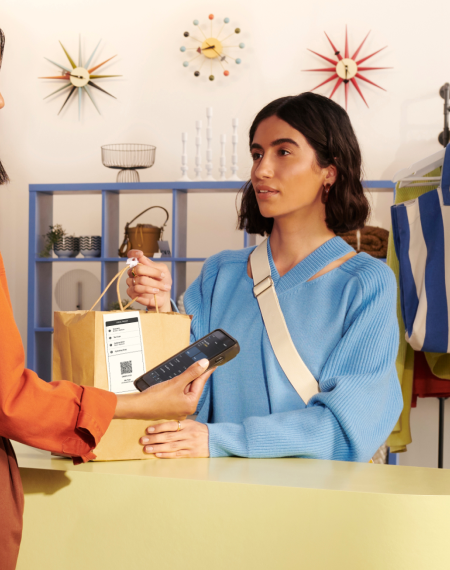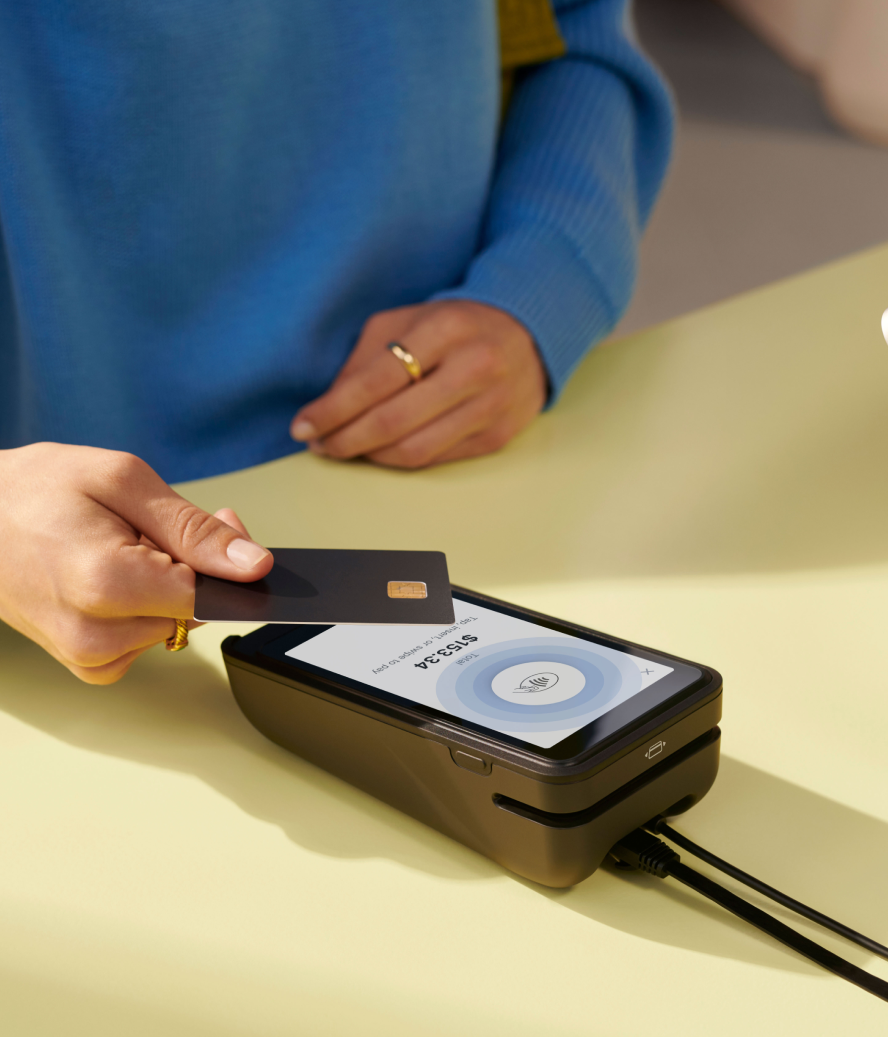If you’ve ever gone shopping, chances are you’ve used a customer-facing display. It shows key information about your purchase: the items in your cart, the total amount to pay, and options to receive your receipt.
As a business owner, you might be considering a customer-facing display as part of your checkout process. Not only does it help collect payment and streamline purchases, but it's an accessible way to keep your business competitive.
This guide shares whether you need a customer-facing display in your store and how to set one up.
What is a customer-facing display?
A customer-facing display is a screen visible to shoppers at the checkout desk. It displays important information about their purchase, such as the products they're buying, how much they cost, and whether they'd like to tip the cashier.
There are two main types of customer-facing displays:
- POS with swivel stand. When on a swivel stand, a POS can be positioned for cashiers and customers to view totals and process payments using the same device. This way, you deal with less hardware. A swivel POS is also easier to travel with and can be used in pop-up shops or seasonal businesses.
- Dedicated device. While the cashier might use their device as the POS system to charge for items, a separate POS device is used as the customer-facing display.
Information shown on a customer-facing display
A customer-facing display shows a customer all the relevant information about their transaction. That includes:
- Order details: A list of purchases is part of what appears in a customer-facing display. The cashier's POS system also displays the same information as they process a transaction.
- Pricing: A full breakdown of each item’s prices, including any discounts or coupons that may be applied.
- Taxes: How much tax a customer owes on their order.
- Payment prompts: Guidance that walks customers through choosing a payment method and paying for their order.
- Receipt options: Customers can get a paper or digital receipt via SMS or email.
- Loyalty information: How many points they’ve earned on this purchase, the rewards they’re eligible to redeem, and how far they’re off the next rewards tier.
- Tips: Let customers show their gratuity to a helpful retail associate by letting them give a tip through the customer-facing display.
- Upsells and cross-sells: Displays can analyze the products in a customer’s cart and recommend complementary or higher-value products to increase basket size.
- Promoted products: Treat your display as a type of digital signage to promote bestselling products, discounts, or exclusive bundles.
Reasons to use customer-facing displays in retail
The digital nature of a customer-facing display offers a list of benefits for retailers to improve the overall customer experience, including:
Improve the checkout experience
A customer-facing display makes checkout a seamless process. Cashiers can easily charge for a purchase, and customers can keep track of what's being added to their total bill.
For example, if a customer adds two sweaters to their cart, assuming a special sale applies to them when it doesn't, they can see the prices for each sweater as they're being processed. Correcting the mistake and only purchasing one sweater can happen then and there.
Mitigate returns
With a customer-facing display you’ll end up making fewer returns, because it lets customers monitor their purchase as it’s being processed. Any questions or changes or errors in prices can be pointed out and discussed in real time, leading to lower return rates.
Collect accurate customer data
Customer-facing displays make it easier to collect customer emails and phone numbers as a point of contact to push sales and promotional campaigns.
Let’s say you’re running a special 25%-off holiday sale in exchange for a customer’s email. A customer-facing display makes it easier for customers to choose to enter their email address to claim the offer rather than having to dictate their personal information to the cashier.
Small operational changes like these can help you collect clean data and build a customer database for future retargeting.
Ensure compliance
Do customers need to sign off on a purchase? Or is there a specification they need to know about before completing a purchase? A customer-facing display makes staying compliant easier. Shoppers can immediately access any important information through the display.
Speed up checkout
A customer-facing display shortens the time it takes to process an order, point out and correct purchase errors, and process contactless payments—the latter of which eliminates the need to pass cards, phones, or paper receipts constantly.
💡Tip: Use email capture inside Shopify POS to build unified customer profiles. It uses a customer’s payment data to identify and match a Shop Pay account. If a match is found, the customer’s email address and phone number are automatically displayed at checkout—no manual entry is required.

Increase loyalty program participation
A customer-facing display lowers the friction between signups to loyalty programs. You can collect a shopper’s email address and enroll them in your loyalty program to increase customer retention.
Shoppers who’ve already enrolled can also view how many points they’ve earned, how far they are off the next reward tier, and show any discounts they’ve redeemed on the display.
Generate extra revenue
Displays are another avenue to connect customers with promotions, in-store offers, bundles, or limited-time deals. They can increase basket size and, ultimately, revenue.
How to set up a customer-facing display
Properly setting up a customer-facing display involves hardware, software, and testing. Here’s a look at each step in more detail.
1. Set up a POS system
A point of sale (POS) system is the command center of your entire retail operation. It’s how you’ll ring up customer orders, process payments, retrieve inventory data, and store data on your customers.
There's a lot that goes into choosing the best POS system. If a customer-facing display is important to you, consider a POS system that supports the use of an additional screen, such as Shopify POS. This way, both the cashier and the customer can see the same data as it's being processed through the system.
2. Acquire compatible display hardware
Your POS system can include several pieces of hardware that work together to help you process purchases—for example, a receipt printer, a scanner, a cash drawer, and a cashier-facing display to look through each transaction as it happens.
Yet your checkout setup can also be as simple as pairing an iPad with a stand and a card reader. For example, if you use an Android tablet with a POS system like Shopify, download the Customer View app. This shows key transaction details on a wireless customer-facing display.
3. Test your new setup
Once your hardware is established and you've integrated the software with it, test your new setup to ensure it's working properly. Check that it records and displays transactions correctly and that it can process every type of payment you accept properly.
Features to look for in a customer-facing display
Customizable screen
Look for a customer-facing display that enables you to customize its dashboard.
Maybe you want to add the option to add a voluntary tip before finalizing a transaction. Perhaps you want to accept store gift cards by having customers swipe their cards when prompted. A robust customer-facing display system enables you to do that.
💡Tip: Shopify POS unifies customer, inventory, and order data anywhere you sell. For example, customers can earn loyalty points on online purchases and view their rewards on the customer-facing display in-store, all without the patchy and expensive middleware typically required to offer these personalized omnichannel experiences at scale.
Brand theming
When evaluating customer-facing displays, prioritize those with robust brand theming capabilities. The best systems allow you to fully customize the interface with your logo, brand colors, custom fonts, and promotional imagery—transforming a standard transaction into a powerful brand touchpoint.
Look for displays that offer flexibility to match seasonal promotions or highlight product images, ensuring customers experience your distinct brand personality throughout checkout. This consistency reinforces your identity at the crucial moment of purchase and creates a cohesive bridge between your online and in-store presence.

Portability
Today, we walk around with computers in our back pockets. The same goes for displays. You don't have to deal with clunky hardware; the best POS and customer-facing display setups are wireless to support this on-the-go checkout process.
Compatibility and integrations
Not all customer-facing display hardware and the POS systems they integrate with are created equally. If you’re a retailer that processes many transactions daily, a unified POS system that integrates with other apps is a wise investment.
Shopify is the only platform to natively build POS and ecommerce on the same system, eliminating the need for complex or patchy integrations to get the functionality you need. Process payments, view customer data, and check inventory levels anywhere you sell, from one platform. This approach helps retailers reduce the total cost of ownership by 22% on average.
If you need out-of-the-box customization, the Shopify App Store is home to hundreds of apps compatible with Shopify POS. That includes:
- Loyalty apps like Marsello and Smile
- Customer feedback tools such as Grapevine and POWR
- Returns management platforms like Navar
💡Tip: Use Shopify POS UI extensions to bring this functionality into your Smart Grid. For example, with the Marsello app extension, cashiers can see how many loyalty points a customer has accumulated (both in-store and online) and redeem any rewards at checkout. All of this information can be displayed on a customer screen.
Do you need a customer-facing display at your store?
Adding a customer-facing display to your checkout workflow can pay off long-term. Not only are they easy to install, but they’re also easy for both cashiers and customers to interact with. They make it easier to improve basket size, lower return rates, and increase customer engagement.
The best part? With Shopify, you don’t need to overhaul your existing tech stack to implement a customer-facing screen at checkout. Use the “Customer view app” to turn any Android tablet into a customer display using the data already unified in your POS system.
Read more
- Merchant Services: Everything Retailers Need To Know
- Chip Credit Cards and Payment Transactions: What Merchants Need To Know
- Everything Store Owners Should Know About Retail Receipts
- EMV Chip Cards are Coming to the U.S. (Here's What Merchants Need to Know)
- What is an EPOS System and How Does it Work?
- What Is Near Field Communication? How to Use It and Why It’s Important
- Card on File Transactions: How to Process Subscriptions & Recurring Payments on Autopilot
- What is EMV and Why Should Merchants Use It?
- Tap to Pay: Everything You Need to Know as a Retailer
Customer-facing display FAQ
What is customer-facing information?
Customer-facing information shown on a retail POS system includes:
- Products purchase
- Taxes
- Payment options
- Receipt options (digital or paper)
- Options to give a tip
- Promoted products
- Loyalty points
What is a point-of-sale customer display?
A POS customer display is a screen or monitor that faces the customer at the checkout desk. It provides customers with real-time information about their purchase, such as the items they’re buying, the price of each item, and any discounts applied.
How much does a POS display cost?
The cost of a POS customer display can vary significantly depending on the POS system and hardware you use. With Shopify, you can cut this cost by using an existing Android tablet as a customer-facing display with the “Customer view” app.







